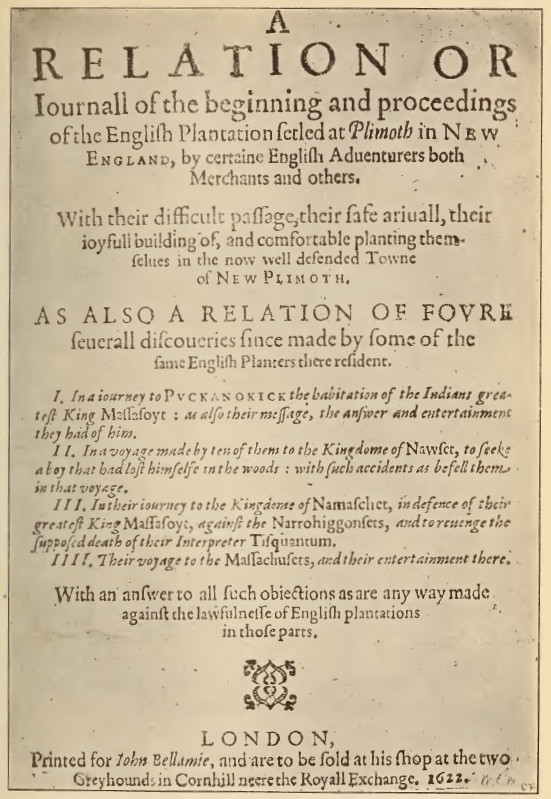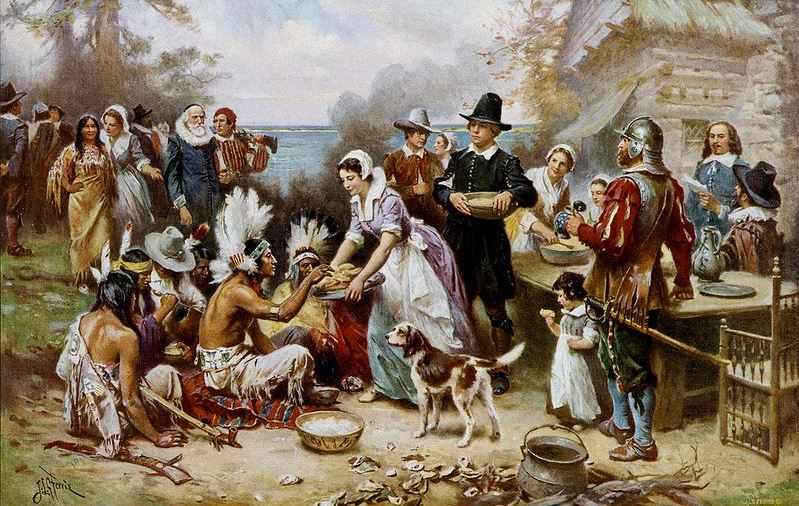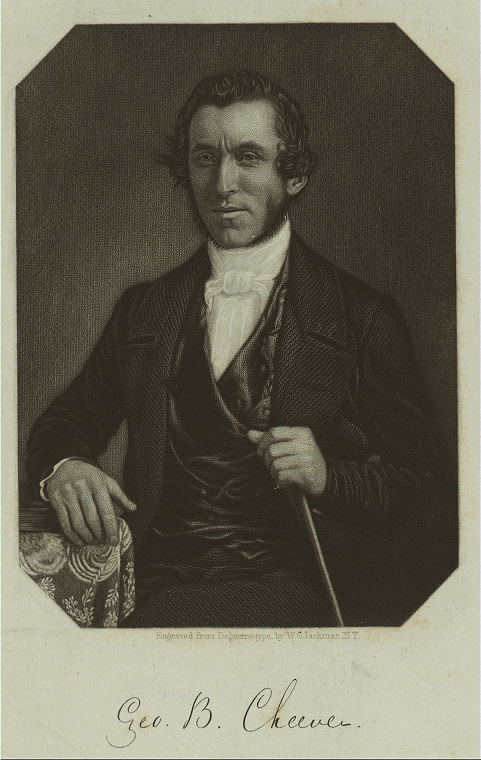The earliest text detailing the settlement of New Plymouth is known as Mourt’s Relation or A Relation or Journal of the Beginning and Proceedings of the English Plantation Settled at Plimoth in New England (1622). Erroneously attributed to fellow settler George Morton, scholars now believe the work to be written by Edward Winslow with contributions from William Bradford. Their names are not quoted as authors to avoid the association of the new settlement with fugitive Brownist separatists – a fact that could spell trouble for the fledgling colony. The manuscript was carried out of New Plymouth by Robert Cushman, Chief Agent in London for the settlers, on board the Fortune in 1621. When Mourt’s Relation was sold in John Bellamy’s London bookshop in the 1620s its readers could have scarcely imagined this would become one of the most well-known texts in American history.

The title page of the original 1622 pamphlet – public domain
Mourt’s Relation is written in the matter-of-fact style of a journal offering a day-by-day account of the first few months of the new settlement. That is not to say the pamphlet is entirely factual. The text is promotional in nature, designed to attract future investment and emigration to the struggling colony. As Dwight B. Heath notes ‘there is little talk of tragedy’ in a work written shortly after the death of nearly half the passengers in the bitter New England winter of 1620/1621.[1] There is some talk of a ‘general sickness’ that troubled the colonists. But overall, the description is a positive one: the pamphlet paints rosy picture of a new land of boundless opportunity:
[A]s we went in another valley we found a fine clear pond of fresh water, being about a musket shot broad and twice as long. There grew also many fine vines, and fowl and deer haunted there; there grew much sassafras. From thence we went on, and found much plain ground, about fifty acres, fit for plow, and some signs where the Indians had formerly planted their corn. [2]
Bradford later characterized Cape Cod as a ‘hideous and desolate wilderness’.[3] In contrast Mourt’s Relation depicts a land with abundant game and rich soil ready for agriculture. The inference here is of a prosperous settlement where riches could be made: a land of plenty and promise. Later poetic treatments of the ‘Pilgrim Fathers’ eulogised the settlers as emigrants of conscience who came not for the ‘Bright jewels of the mine’ or ‘The wealth of seas’ but simply for religious freedom. Mourt’s Relation tells a very different story.
Indeed, Bradford uses Mourt’s Relation to describe whales ‘playing hard by us’ and stated that had they ‘instruments & means to take them, we might have made a very rich return’.[4] Foregrounding the potential of whaling as a source of income Bradford included the assessment of Christopher Jones, captain of the Mayflower, who estimated that they could have ‘made three or four thousand pounds worth of oil’ and that he ‘preferred it before Greenland Whale-fishing, & purpose the next winter to fish for Whale here’.[5] The contrast with Felicia Hemans’ rendering of the Pilgrims as men disinterested in the ‘wealth of seas’ could not be more clear.
In the end it was not whaling but the fur trade that saw New Plymouth become a profitable colony. James Truslow Adams records how the new colony quickly made a substantial contribution to the lucrative trade in Beaver pelts:
Although gone only four days, the little party of thirteen, under command of Standish, were eminently successful in all three objects, making the first beginning, on any large scale, of that trade which was to prove their financial salvation. In fact the Bible and the beaver were the two mainstays of the young colony. The former saved its morale, and the latter paid its bills; and the rodent’s share was a large one. The original foundations of New York, New England, and Canada all rest on the Indian trade, in which the item of beaver-skins was by far the most important and lucrative.[6]
In a very short period, New Plymouth joined in with the fur trade, a mainstay of colonial profiteering, which ultimately secured the future of the colony. Whereas the nineteenth and early twentieth-century imagined the ‘Pilgrim Fathers’ to be above worldly pursuits, Mourt’s Relation reminds us of the reality of settler colonialism.
Mourt’s Relation also reminds us that there were many other settlers onboard the Mayflower who were not persecuted religious dissenters. The text makes reference to both ‘strangers and pilgrims’.[7] ‘Strangers’ used in this context refers to the motley collection of travellers who joined the separatists on their journey to the New World. These ‘English adventurers and merchants’ were an assortment of colonial settlers and indentured servants loyal to the Church of England and seeking wealth and fortune in the New World. They are often forgotten in the celebratory history of the ‘Pilgrim Fathers’ but their presence here demonstrates to us that the Mayflower voyage was a colonial project with wealth as its core.
These details sat uneasily with later generations of American authors and historians. In the 19th century American writers began to construct a distinctly American literary tradition and national past. A key text was Samuel Lorenzo Knapp’s Lectures on American Literature where he made the claim that the Pilgrim Fathers were unlike other colonial settlers of the period:
Our ancestors were not, like some colonists, disgorged from the mother country to keep the remaining population sound and pure; there were not a surplus mass thrown off to prevent national apoplexy, or political spasms […] nor were they sent by the parent country to extend her commerce, or to gain a footing on, or near, the territories of other nations. They did not come to this country as the Spanish or French colonists […] allured by the golden dreams of avarice, or by the glowing description of the luxuriance of the soil […].[8]
Knapp even went so far as to term the Mayflower Compact the ‘Magna Charta of American liberties’ and wished ‘honour to the intellects of those who formed it’. However, the plainly promotional and mercantile elements sat uneasily with this narrative. Knapp dismissed Mourt’s Relation as the writing of a ‘merchant adventurer’ produced for a market ‘where the avaricious were still indulging dreams of gold’. In summary, the text was beneath the high-minded mission of the Puritans.
Other nineteenth century writers found more to celebrate in Mourt’s Relation. The abolitionist George B. Cheever used the 1622 pamphlet in the fight against slavery. Republishing the entirety of Mourt’s Relation in The Journal of the Pilgrims at Plymouth (1848), Cheever celebrated their mercantile ambitions precisely because they did not depend on slavery in their pursuit of profit. According to Cheever, Mourt’s Relation was ‘written by a people who were all labouring with their hands for their daily bread, and struggling also for the subsistence of others thrown upon them’ to make their colony work.[9] The implication is clear: America has lost its way with its immoral reliance on slavery. Mourt’s Relation is offered as an example of national origins built on self-sufficiency rather than exploitation.
Perhaps the most significant feature of Mourt’s Relation is its inclusion of ‘The Mayflower Compact’: the first governing document of Plymouth Colony. Singed on November 21 1620 (prior to landing), the text gave a legal framework of government to the eventual settlement:
In the Name of God, Amen. We whose names are underwritten, the loyal subjects of our dread Sovereign Lord King James, by the Grace of God of Great Britain, France, and Ireland King, Defender of the Faith, etc. Having undertaken, for the Glory of God and advancement of the Christian Faith and Honour of our King and Country, a Voyage to plant the First Colony in the Northern Parts of Virginia, do by these presents solemnly and mutually in the presence of God and one of another, Covenant and Combine ourselves together in a Civil Body Politic, for our better ordering and preservation and furtherance of the ends aforesaid; and by virtue hereof to enact, constitute and frame such just and equal Laws, Ordinances, Acts, Constitutions and Offices, from time to time, as shall be though most meet and convenient for the general good of the Colony, unto which we promise all due submission and obedience. In witness whereof we have hereunder subscribed our names at Cape Cod, the 11th of November, in the year of the reign of our Sovereign Lord King James, of England, France and Ireland the eighteenth, and of Scotland the fifty-fourth. Anno Domini 1620.[10]
Over time the Mayflower Compact has become revered as an antecedent to the American Constitution or the ‘Magna Charta of American liberties’ to use Knapp’s description. During the 1920 tercentenary celebrations future president Calvin Coolidge made the following comments:
The compact which they signed was an event of the greatest importance. It was the foundation of liberty based on law and order, and that tradition has been steadily upheld. They drew up a form of government which has been designated as the first real constitution of modern times. It was democratic, an acknowledgment of liberty under law and order and the giving to each person the right to participate in the government, while they promised to be obedient to the laws. [11]
The inclusion of the Compact in Mourt’s Relation had far more immediate and pragmatic concerns, however. Primarily it established the colony as an extension of the King’s authority: ‘our dread Sovereign Lord King James’. Knapp’s ‘Magna Charter’ analogy seems particularly ironic given the deferment to royal authority: but this was vital to secure investment and assuage any anxiety concerning the dissenting beliefs of many of the settlers. The Compact closely resembles a seventeenth-century patent helping to secure a legal claim to the territory: the Mayflower did not land in ‘the Northern Parts of Virginia’ as originally arranged – but further south near Cape Cod. Finally, there was also the thorny issue of the ‘strangers’ and the separatists. The Compact was printed in Mourt’s Relation to give the impression of unanimous agreement and accord between the different social groups.
The reality was quite different. The Mayflower was beset by disagreement between the disparate groups on board. Bradford would later recollect the difficulties in On Plimouth Plantation:
There was a proud and very profane young man, one of the seamen, of a lusty, able body, which made him the more haughty; he would always be contemning the poor people in their sickness and cursing them daily with grievous execrations; and did not let to tell them that he hoped to help to cast half of them overboard before they came to their journey’s end, and to make merry with what they had; and if he were gently reproved, he would curse and swear most bitterly.[12]
Moreover, Of Plimouth Plantation would record many disagreements between the different groups of settlers. Any details of this exposed to the outside world would threaten the future of the colony. Mourt’s Relation was therefore designed to offer an image of a peaceful colony free of factionalism.

The First Thanksgiving 1621, oil on canvas by Jean Leon Gerome Ferris (1899).
The intention is the same with the description of the Native American tribe local to the area: the Wampanoag. Mourt’s Relation focuses on cordial relations and the abundance of food:
At this town of Massasoit’s where we before ate, we were again refreshed with a little fish; and bought about a handful of meal of their parched corn, which was very precious at that time of the year, and a small string of dried shell-fish, as big as oysters. The latter we gave to the six savages that accompanied us, keeping the meal for ourselves; when we drank, we ate each a spoonful of it with a pipe of tobacco.[13]
The text is keen to ensure the English readers are confident of good relations with the ‘savages’. Although only small component of Mourt’s Relation the details of meals taken with the Native Americans later came to be celebrated as the ‘First Thanksgiving’. This was, however, a much later phenomenon. As Robert Tracy McKenzie says:
It became a fact of history – as opposed to an event in the past – not in 1621 but in 1841, the year Winslow’s account of the Pilgrims’ harvest celebration re-entered the historical record. They key figure in the process was Reverend Alexander Young, a New England born Unitarian Minister with a passion for local history. Working with a copy of Mourt’s Relation discovered in Philadelphia a generation earlier. Young included the text of the pamphlet in a compilation of historical documents he titled Chronicles of the Pilgrim Fathers. […] [W]hen [Young] came to Winslow’s allusion to the Pilgrim’s celebration, the well meaning clergyman explained to his audience that what they were reading was an account of the ‘first thanksgiving … of New England’. […] Over the course of the next century the Pilgrims’ festival would gradually become central to the popular memory of the Thanksgiving holiday. [14]
The afterlife of these small details from Mourt’s Relation has been profound. Its influence on the historical culture of twentieth-century America is hard to overstate; as the events of 1621 have become inseparable from the modern celebration of Thanksgiving for millions of people. One may argue that this ignores the historical reality of early colonial life – but so does Mourt’s Relation in its bid to present a favourable picture of the colony for its English audience.
Mourt’s Relation is more than a simple journal chronicling the founding of a new colony. It is at once a promotional tract, an appeal for investment, a claim to authority for a settlement of dubious legality, and an attempt to secure a future after a disastrous winter. Written in a style familiar to an English audience in the early seventeenth century Bradford and Winslow had to obscure as much as they wanted to reveal of the fortunes on New Plymouth. There is scant reference to the heavy death count, difficulties of housing, food, and uncertain future. Certain truths had to be concealed and others embellished to construct an appropriate narrative. In this way Mourt’s Relation is in keeping with the four centuries of Mayflower literature that followed. Whether we look at the celebratory poetry of the Romantics, the fiery invective of the Chartists, or even the revolutionary poetry of John Boyle O’Reilly all writers had to work creatively to embellish and obscure the details of the Mayflower story to suit their needs. From this perspective Mourt’s Relation reminds us that the practice of enmeshing history and fiction began as soon as New Plymouth was founded.
[1] Dwight B. Heath, Mourt’s Relation: A Journal of the Pilgrims at Plymouth (Bedford, MA: Applewood Books, 1963), p.viii.
[2] Heath, p.21.
[3] Samuel Eliot Morison, Of Plymouth Plantation, 1620-1647 (New York: Alfred A. Knopf, 2002), p.62.
[4] Heath, p.16.
[5] Ibid.
[6] James Truslow Adams, The Founding of New England (Boston: The Atlantic Monthly Press, 1921), p.129.
[7] Heath, p.89.
[8] Samuel Lorenzo Knapp, Lectures on American Literature (New York: Elam Bliss, 1829), p.36.
[9] George B. Cheever, The Pilgrim Fathers: Or, The Journal of the Pilgrims at Plymouth (Glasgow: William Collins, 1848), p.202.
[10] Heath, p.17.
[11] New York Herald, Nov. 23, 1920 p. 6.
[12] Morison, Of Plymouth Plantation, p.62.
[13] Heath, p.67.
[14] Robert Tracy McKenzie, The First Thanksgiving: What the Real Story Tells Us About Loving God an Learning from History (Illinois: InterVarsity Press, 2013), p.150.

